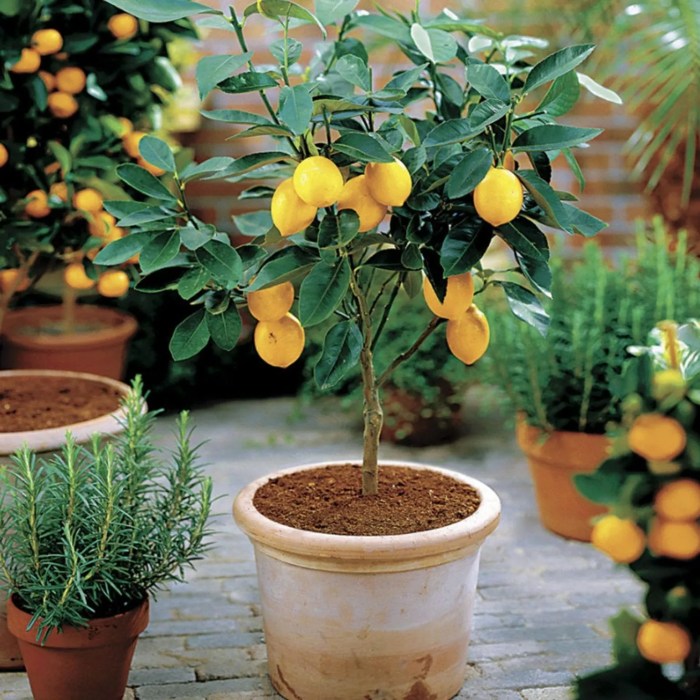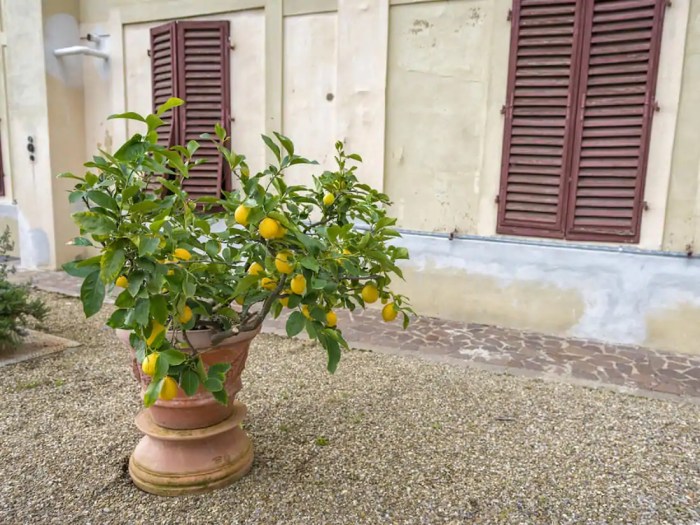Plant a Lemon Tree in a Pot A Complete Guide
Planting and Initial Care: Plant A Lemon Tree In A Pot
Plant a lemon tree in a pot – The seemingly simple act of planting a lemon tree sapling in a pot is fraught with potential pitfalls for the unwary. Success hinges on a precise understanding of the plant’s needs and a rigorous adherence to best practices. Failure to do so can result in a stunted, unproductive tree, a bitter disappointment for even the most seasoned horticultural enthusiast.
This section Artikels the crucial steps involved, leaving no room for the amateurish mistakes that plague so many well-intentioned gardeners.
Proper planting and initial care are paramount for the long-term health and productivity of your lemon tree. Neglect in these early stages can have cascading negative consequences, impacting fruit yield and overall plant vitality for years to come. This is not merely a matter of aesthetics; it’s an investment that demands attention to detail.
Planting a Lemon Tree Sapling
The delicate balance between root health and soil composition is the cornerstone of successful planting. Improper handling can irrevocably damage the root system, leading to stunted growth or even death. The following steps provide a roadmap to avoid such calamities.
- Select a pot of appropriate size, ensuring adequate drainage. A 15-20 gallon pot is generally suitable for a young sapling, allowing for several years of growth before repotting becomes necessary.
- Use a well-draining potting mix specifically formulated for citrus trees. Avoid using garden soil, as it often lacks the necessary aeration and drainage. A blend of peat moss, perlite, and compost is ideal.
- Gently remove the sapling from its nursery container, taking care not to damage the roots. If the roots are root-bound, carefully loosen them to encourage outward growth.
- Place the sapling in the center of the pot, ensuring the top of the root ball is level with the soil surface. Fill the pot with the potting mix, gently firming the soil around the roots to eliminate air pockets.
- Water thoroughly after planting, allowing excess water to drain from the drainage holes. Avoid overwatering, as this can lead to root rot.
Watering a Newly Planted Lemon Tree
Maintaining the correct moisture level is a critical aspect of initial care. Both underwatering and overwatering can severely impact the health of your young lemon tree. Understanding the signs of each is essential for successful cultivation.
- Underwatering: Leaves will appear dry and brittle, drooping noticeably. The soil will be dry to the touch, even several inches below the surface. Immediate deep watering is necessary.
- Overwatering: Leaves may appear yellow and wilted, even though the soil is moist. The soil may have a foul odor, indicating root rot. Allow the soil to dry out considerably before watering again. Consider repotting if root rot is suspected.
Ideal Location for a Potted Lemon Tree
The location of your potted lemon tree directly impacts its growth and fruit production. Careful consideration of sunlight and wind protection is crucial for maximizing its potential.
A location receiving at least six hours of direct sunlight per day is ideal. A south-facing location (in the Northern Hemisphere) is typically best. Protection from strong winds is also important, as they can damage the leaves and branches. A sheltered patio or balcony is often a suitable location. Consider using a windbreak if necessary.
Ongoing Care and Maintenance

The seemingly idyllic life of a potted lemon tree is, in reality, a constant political struggle for survival against the forces of neglect and environmental tyranny. Failure to provide consistent and appropriate care will result in a weak, unproductive, and ultimately, a deceased citrus dictator. The following Artikels the necessary actions to maintain your lemon tree’s power and productivity.Maintaining a thriving potted lemon tree demands a ruthless regime of care, not unlike the iron fist of a benevolent, yet demanding, horticultural overlord.
Neglect will be swiftly punished with a meager harvest, or worse, the complete collapse of your citrus kingdom. Success hinges on understanding the specific needs of your arboreal subject and implementing a strict, yet effective, maintenance schedule.
Fertilization Strategies for Optimal Yield
Potted lemon trees, unlike their free-range cousins, are entirely dependent on the gardener for their nutritional needs. Depriving them of essential nutrients is akin to political sabotage, leading to stunted growth and diminished fruit production. A balanced, slow-release fertilizer specifically formulated for citrus trees is essential. Applying a granular fertilizer according to package instructions, typically every 2-3 months during the growing season (spring and summer), provides a consistent supply of nutrients.
Liquid fertilizers can be used as supplements, applied every 2 weeks, but should be diluted to avoid root burn—a horticultural equivalent of a devastating economic crisis. The precise amounts and types will vary depending on the tree’s size and the soil’s composition; always consult product instructions for the optimal dosage to avoid either nutrient starvation or fertilizer poisoning.
Over-fertilization can be as damaging as under-fertilization.
Pruning Techniques for Shape and Size Control
Pruning is not simply about removing unwanted branches; it’s a crucial element in shaping the political landscape of your lemon tree. Proper pruning promotes airflow, sunlight penetration, and overall health, preventing disease and maximizing fruit production. Winter is the ideal time for major pruning. Remove any dead, diseased, or crossing branches, maintaining an open canopy structure to prevent overcrowding.
Planting a lemon tree in a pot offers a rewarding experience, requiring careful attention to its nutritional needs. Understanding plant nutrition extends beyond citrus; for instance, selecting the right fertilizer is crucial, as highlighted by resources such as this guide on fertilizer for rubber tree plant , which illustrates the importance of tailored nutrient blends. Returning to our lemon tree, proper fertilization ensures healthy growth and abundant fruit.
During the growing season, remove any suckers or water sprouts that emerge from the base or trunk. These are unproductive branches that divert energy away from fruit production, like parasitic political factions diverting resources from the state. Techniques such as heading back (cutting back the tips of branches) can be used to control the size and shape of the tree, preventing it from becoming too large for its container.
Regular, strategic pruning is vital for maintaining the health and productivity of your potted lemon tree.
Routine Maintenance Schedule
The following schedule provides a basic framework. Adjustments may be needed based on environmental conditions and the specific needs of your tree.
| Task | Frequency | Method | Notes |
|---|---|---|---|
| Watering | As needed, keeping soil slightly moist | Water thoroughly until water drains from drainage holes | Avoid overwatering, which can lead to root rot. Check soil moisture before watering. |
| Fertilizing | Every 2-3 months (spring and summer) | Apply slow-release granular fertilizer or liquid fertilizer every 2 weeks | Follow package instructions for dosage. |
| Pest and Disease Monitoring | Weekly | Inspect leaves and branches for signs of pests or diseases | Take prompt action to address any issues. |
| Pruning | Winter (major pruning); growing season (light pruning) | Remove dead, diseased, crossing, or unproductive branches. | Maintain an open canopy structure. |
Harvesting and Using Lemons

The culmination of your diligent lemon tree cultivation arrives with the harvest. Understanding the optimal timing and proper storage techniques is crucial to maximizing the enjoyment and utility of your homegrown bounty. Failure to do so represents a squandered opportunity, a political failure of the highest order in the microcosm of your citrus empire.
Lemon ripeness is not solely determined by color, a common misconception propagated by the lemon industrial complex. While a vibrant yellow hue is a good indicator, the true test lies in the firmness and weight of the fruit. A ripe lemon will feel heavy for its size, with a slightly soft texture, unlike the rock-hard unripeness of commercially produced lemons, often picked prematurely to endure long-distance transport and the tyranny of shelf life.
Lemon Ripeness and Optimal Harvesting Time, Plant a lemon tree in a pot
The ideal time for harvesting is typically 7-10 months after flowering, depending on the variety and growing conditions. However, the ultimate arbiter of ripeness is the fruit itself. Avoid the pitfalls of harvesting based solely on calendar dates; engage in a direct assessment of the fruit’s physical attributes. A lemon that yields easily to gentle pressure, but doesn’t feel mushy, has reached its zenith.
Harvesting at the peak of ripeness ensures optimal flavor and juice content, a testament to your horticultural prowess and a slap in the face to the mass-produced, flavorless lemons that dominate the market.
Storing Harvested Lemons
Proper storage is paramount to preserving the quality and longevity of your harvest. Improper storage is a betrayal of your lemon tree’s hard work and a culinary crime against humanity.
Whole lemons, unwashed, can be stored at room temperature for up to a week. For extended storage, refrigeration is the preferred method. Place lemons in a perforated plastic bag or container to allow for air circulation, preventing the development of mold and rot, a clear indication of horticultural negligence.
Creative Uses for Homegrown Lemons
The culinary and non-culinary applications of homegrown lemons are as vast as the possibilities of a truly free society. Don’t limit yourself to the tired tropes of lemonade and lemon meringue pie; embrace the revolutionary potential of your harvest.
Beyond the expected culinary uses (lemonade, lemon zest in baking, etc.), consider infusing olive oil with lemon zest for a vibrant, aromatic oil. Or create a lemon-infused salt by combining finely grated lemon zest with coarse sea salt, a powerful weapon against the blandness of mass-produced culinary products. The possibilities are limited only by your imagination, and perhaps, the size of your harvest.
For example, consider using lemon juice as a natural cleaning agent, a potent symbol of self-sufficiency in the face of the corporate cleaning product behemoths. The pungent aroma alone serves as a potent political statement against chemical-laden cleaning products.
Commonly Asked Questions
Can I grow a lemon tree in a pot indoors?
Yes, but it requires careful consideration of light, humidity, and temperature. Supplement with grow lights if natural light is insufficient.
How often should I repot my lemon tree?
Repot every 1-2 years, or when roots become root-bound, into a slightly larger pot.
What are the signs of a nutrient deficiency in my lemon tree?
Yellowing leaves, stunted growth, and poor fruit production can indicate nutrient deficiencies. Regular fertilization is crucial.
What should I do if my lemon tree drops its leaves?
Leaf drop can be caused by several factors including stress (temperature fluctuations, underwatering, overwatering). Check for pests and diseases too.
How do I protect my lemon tree from frost?
Move the pot indoors to a cooler, frost-free location, or cover it with a frost blanket or tarp.
